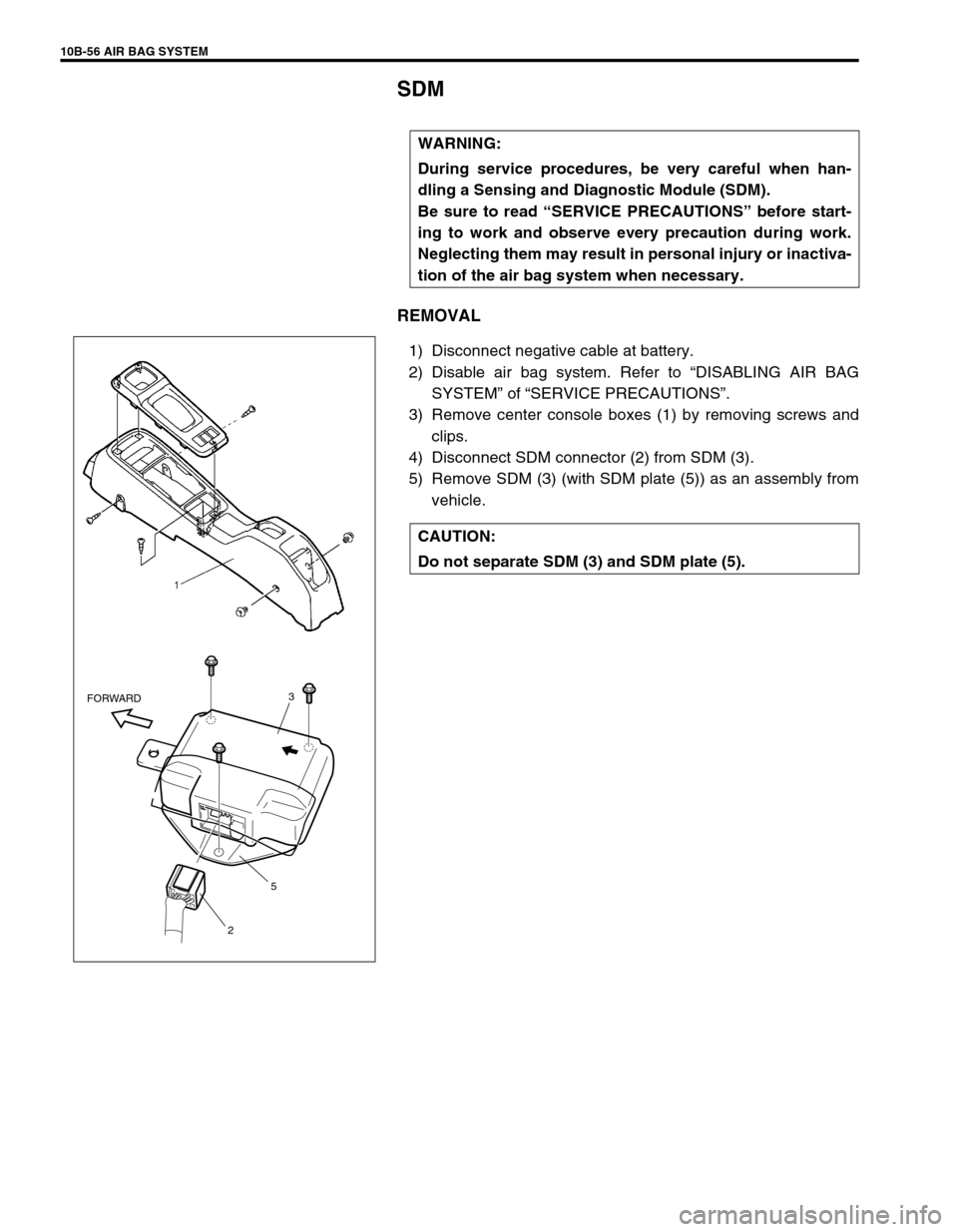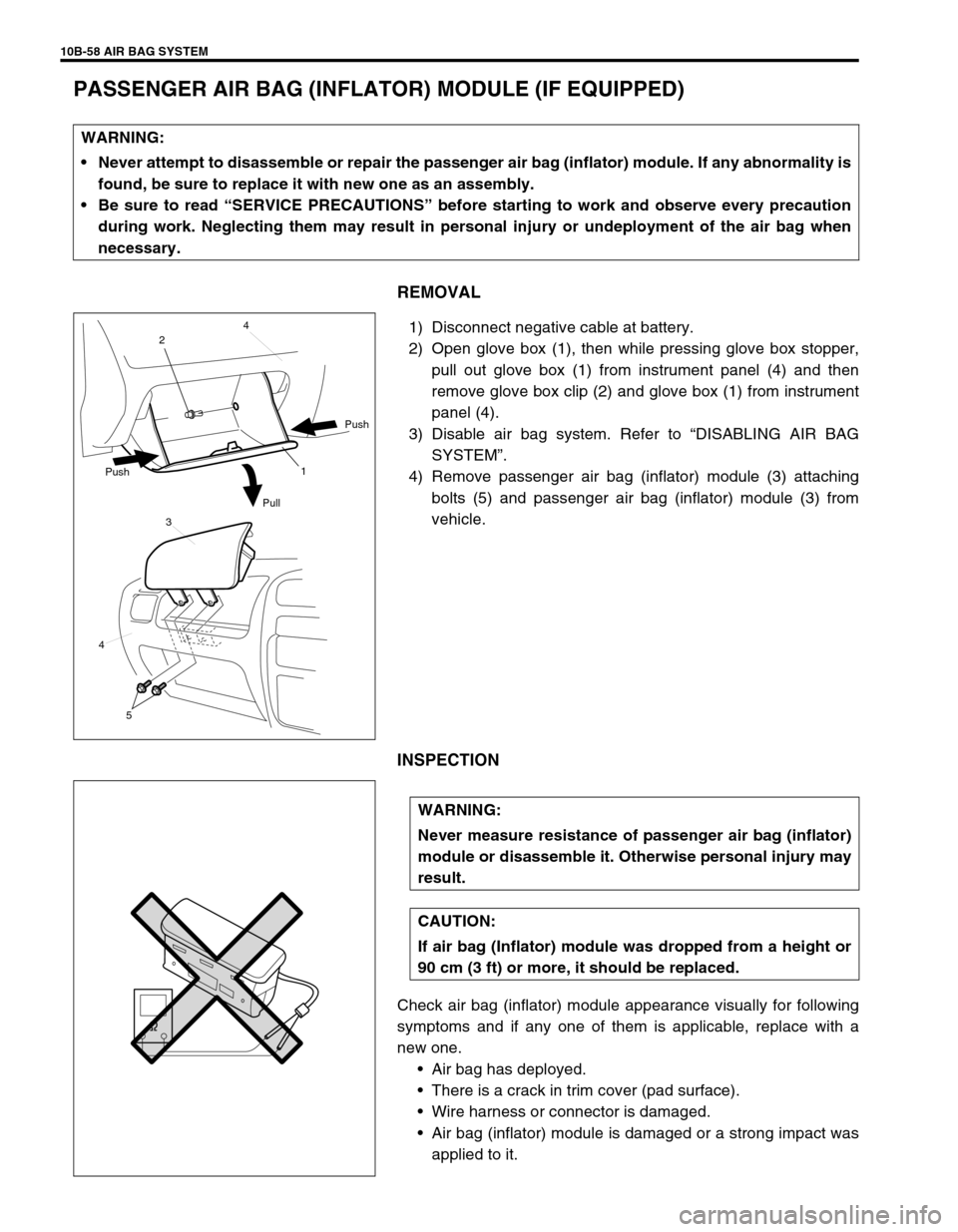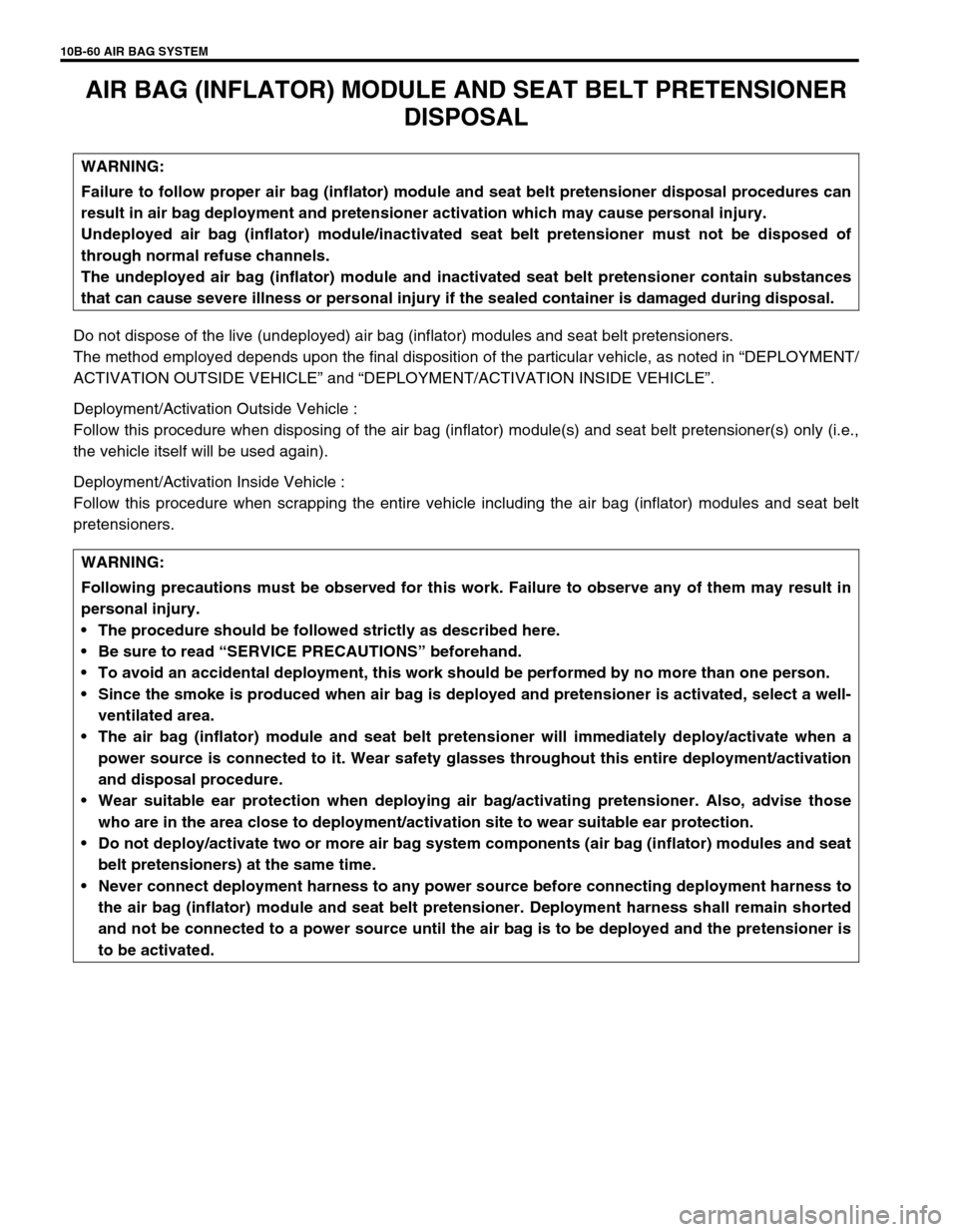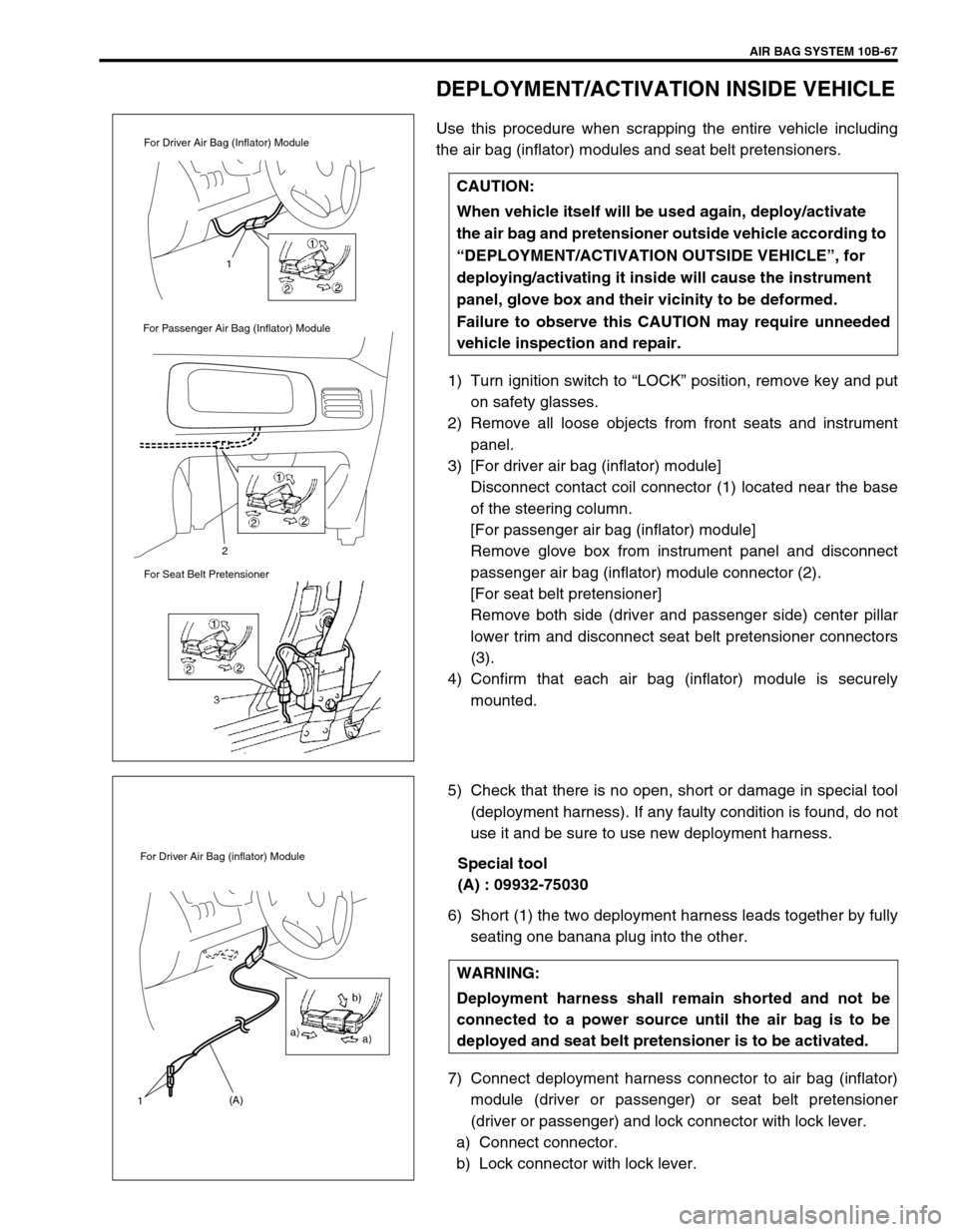ring SUZUKI SWIFT 2000 1.G Transmission Service Workshop Manual
[x] Cancel search | Manufacturer: SUZUKI, Model Year: 2000, Model line: SWIFT, Model: SUZUKI SWIFT 2000 1.GPages: 447, PDF Size: 10.54 MB
Page 430 of 447

10B-56 AIR BAG SYSTEM
SDM
REMOVAL
1) Disconnect negative cable at battery.
2) Disable air bag system. Refer to “DISABLING AIR BAG
SYSTEM” of “SERVICE PRECAUTIONS”.
3) Remove center console boxes (1) by removing screws and
clips.
4) Disconnect SDM connector (2) from SDM (3).
5) Remove SDM (3) (with SDM plate (5)) as an assembly from
vehicle. WARNING:
During service procedures, be very careful when han-
dling a Sensing and Diagnostic Module (SDM).
Be sure to read “SERVICE PRECAUTIONS” before start-
ing to work and observe every precaution during work.
Neglecting them may result in personal injury or inactiva-
tion of the air bag system when necessary.
CAUTION:
Do not separate SDM (3) and SDM plate (5).
3
5
2 FORWARD
Page 432 of 447

10B-58 AIR BAG SYSTEM
PASSENGER AIR BAG (INFLATOR) MODULE (IF EQUIPPED)
REMOVAL
1) Disconnect negative cable at battery.
2) Open glove box (1), then while pressing glove box stopper,
pull out glove box (1) from instrument panel (4) and then
remove glove box clip (2) and glove box (1) from instrument
panel (4).
3) Disable air bag system. Refer to “DISABLING AIR BAG
SYSTEM”.
4) Remove passenger air bag (inflator) module (3) attaching
bolts (5) and passenger air bag (inflator) module (3) from
vehicle.
INSPECTION
Check air bag (inflator) module appearance visually for following
symptoms and if any one of them is applicable, replace with a
new one.
Air bag has deployed.
There is a crack in trim cover (pad surface).
Wire harness or connector is damaged.
Air bag (inflator) module is damaged or a strong impact was
applied to it. WARNING:
Never attempt to disassemble or repair the passenger air bag (inflator) module. If any abnormality is
found, be sure to replace it with new one as an assembly.
Be sure to read “SERVICE PRECAUTIONS” before starting to work and observe every precaution
during work. Neglecting them may result in personal injury or undeployment of the air bag when
necessary.
1 24
Push
Pull Push
3
4
5
WARNING:
Never measure resistance of passenger air bag (inflator)
module or disassemble it. Otherwise personal injury may
result.
CAUTION:
If air bag (Inflator) module was dropped from a height or
90 cm (3 ft) or more, it should be replaced.
Page 434 of 447

10B-60 AIR BAG SYSTEM
AIR BAG (INFLATOR) MODULE AND SEAT BELT PRETENSIONER
DISPOSAL
Do not dispose of the live (undeployed) air bag (inflator) modules and seat belt pretensioners.
The method employed depends upon the final disposition of the particular vehicle, as noted in “DEPLOYMENT/
ACTIVATION OUTSIDE VEHICLE” and “DEPLOYMENT/ACTIVATION INSIDE VEHICLE”.
Deployment/Activation Outside Vehicle :
Follow this procedure when disposing of the air bag (inflator) module(s) and seat belt pretensioner(s) only (i.e.,
the vehicle itself will be used again).
Deployment/Activation Inside Vehicle :
Follow this procedure when scrapping the entire vehicle including the air bag (inflator) modules and seat belt
pretensioners.WARNING:
Failure to follow proper air bag (inflator) module and seat belt pretensioner disposal procedures can
result in air bag deployment and pretensioner activation which may cause personal injury.
Undeployed air bag (inflator) module/inactivated seat belt pretensioner must not be disposed of
through normal refuse channels.
The undeployed air bag (inflator) module and inactivated seat belt pretensioner contain substances
that can cause severe illness or personal injury if the sealed container is damaged during disposal.
WARNING:
Following precautions must be observed for this work. Failure to observe any of them may result in
personal injury.
The procedure should be followed strictly as described here.
Be sure to read “SERVICE PRECAUTIONS” beforehand.
To avoid an accidental deployment, this work should be performed by no more than one person.
Since the smoke is produced when air bag is deployed and pretensioner is activated, select a well-
ventilated area.
The air bag (inflator) module and seat belt pretensioner will immediately deploy/activate when a
power source is connected to it. Wear safety glasses throughout this entire deployment/activation
and disposal procedure.
Wear suitable ear protection when deploying air bag/activating pretensioner. Also, advise those
who are in the area close to deployment/activation site to wear suitable ear protection.
Do not deploy/activate two or more air bag system components (air bag (inflator) modules and seat
belt pretensioners) at the same time.
Never connect deployment harness to any power source before connecting deployment harness to
the air bag (inflator) module and seat belt pretensioner. Deployment harness shall remain shorted
and not be connected to a power source until the air bag is to be deployed and the pretensioner is
to be activated.
Page 435 of 447

AIR BAG SYSTEM 10B-61
DEPLOYMENT/ACTIVATION OUTSIDE VEHI-
CLE
Use this procedure when the vehicle itself is used again (only the
air bag (inflator) module(s) and seat belt pretensioner(s) are dis-
posed).
1) Turn ignition switch to “LOCK”, position remove key and put
on safety glasses.
2) Check that there is no open, short or damage in special tool
(deployment harness). If any faulty is found, do not use it
and be sure to use new deployment harness.
Special tool
(A) : 09932-75030
3) Short (1) the two deployment harness leads together by fully
seating one banana plug into the other.
4) Remove air bag (inflator) module(s) and seat belt preten-
sioner(s) from vehicle, referring to SECTION 3C, 10B and
10. WARNING:
Deployment harness shall remain shorted and not be
connected to a power source until the air bag is to be
deployed and seat belt pretensioner is to be activated.
WARNING:
Always carry live air bag (inflator) module with trim
cover away from you.
When storing a live air bag (inflator) module or when
leaving a live air bag (inflator) module unattended on a
bench or other surface, always face the bag and trim
cover up and away from the surface. As the live pas-
senger air bag (inflator) module must be placed with its
bag (trim cover) facing up, place it on the workbench
with a slit (1) or use the workbench vise (2) to hold it
securely at its lower mounting bracket (3).
This is necessary so that a free space is provided to
allow the air bag to expand in the unlikely event of
accidental deployment.
Failure to follow procedures may result in personal
injury.
1
3
32
Page 437 of 447

AIR BAG SYSTEM 10B-63
c) Fill plastic reservoir in fixture (special tool) with water or
sand. This is necessary to provide sufficient stabilization of
the fixture during deployment.
d) Attach the passenger air bag (inflator) module in the fixture
(special tool) using mounting attachment, hold-down bolts
and nuts and M8 bolts and nuts (3).
Securely hand-tighten all fastener prior to deployment.
[In case of seat belt pretensioner]
a) Pull out the webbing (2) fully as shown in the figure and cut
it at the root of the pretensioner (retractor assembly) (1) as
shown in the figure.
b) Clear a space on the ground about 185 cm (6 ft) (4) in
diameter where the seat belt pretensioner (retractor assem-
bly) (1) is to be activated. A paved, outdoor location where
there is no activity is preferred. If an outdoor location is not
available, a space on the shop floor where there is no activ-
ity and sufficient ventilation is recommended.
Ensure no loose or flammable objects are within the activa-
tion area.
c) Place the seat belt pretensioner (retractor assembly) (1) as
shown in the figure on the ground in the space just cleared. CAUTION:
Be sure to use the following bolt and nut for fixing
passenger air bag (inflator) module to mounting
attachment.
Size : M8, Strength : 7T
WARNING:
As the drum (3) of the retractor assembly (1) turns very
quickly as soon as the webbing (2) is cut, fix the retractor
assembly (1) with a vise on the workbench and keep your
hands and fingers away from it when cutting the webbing
(2).
Page 441 of 447

AIR BAG SYSTEM 10B-67
DEPLOYMENT/ACTIVATION INSIDE VEHICLE
Use this procedure when scrapping the entire vehicle including
the air bag (inflator) modules and seat belt pretensioners.
1) Turn ignition switch to “LOCK” position, remove key and put
on safety glasses.
2) Remove all loose objects from front seats and instrument
panel.
3) [For driver air bag (inflator) module]
Disconnect contact coil connector (1) located near the base
of the steering column.
[For passenger air bag (inflator) module]
Remove glove box from instrument panel and disconnect
passenger air bag (inflator) module connector (2).
[For seat belt pretensioner]
Remove both side (driver and passenger side) center pillar
lower trim and disconnect seat belt pretensioner connectors
(3).
4) Confirm that each air bag (inflator) module is securely
mounted.
5) Check that there is no open, short or damage in special tool
(deployment harness). If any faulty condition is found, do not
use it and be sure to use new deployment harness.
Special tool
(A) : 09932-75030
6) Short (1) the two deployment harness leads together by fully
seating one banana plug into the other.
7) Connect deployment harness connector to air bag (inflator)
module (driver or passenger) or seat belt pretensioner
(driver or passenger) and lock connector with lock lever.
a) Connect connector.
b) Lock connector with lock lever.CAUTION:
When vehicle itself will be used again, deploy/activate
the air bag and pretensioner outside vehicle according to
“DEPLOYMENT/ACTIVATION OUTSIDE VEHICLE”, for
deploying/activating it inside will cause the instrument
panel, glove box and their vicinity to be deformed.
Failure to observe this CAUTION may require unneeded
vehicle inspection and repair.
1
2
For Driver Air Bag (Inflator) Module
For Passenger Air Bag (Inflator) Module
For Seat Belt Pretensioner
WARNING:
Deployment harness shall remain shorted and not be
connected to a power source until the air bag is to be
deployed and seat belt pretensioner is to be activated.
(A)
1
For Driver Air Bag (inflator) Module
Page 442 of 447

10B-68 AIR BAG SYSTEM
8) Route deployment harness out the vehicle.
9) Verify that the inside of the vehicle and the area surrounding
the vehicle are clear of all people and loose or flammable
objects.
10) Stretch the deployment harness to its full length 10 m (33 ft)
(1).
Special tool
(A) : 09932-75030
11) Place a power source near the shorted end (3) of the deploy-
ment harness. Recommended application: 12 Volts mini-
mum, 2 amps minimum. A vehicle battery is suggested.
12) Completely cover windshield area and front door window
openings with a drop cloth, blanket to similar item (2). This
reduces the possibility of injury due to possible fragmenta-
tion of the vehicle’s glass or interior.
13) Notify all people in the immediate area that you intend to
deploy the air bag (inflator) module or activate the seat belt
pretensioner.
.
NOTE:
When the air bag deploys and the pretensioner acti-
vates, the rapid gas expansion will create a substantial
report. Wear suitable ear protection. Notify all people
in the immediate area that you intend to deploy the air
bag (inflator) module or to activate the seat belt preten-
sioner and suitable ear protection should be worn.
After the air bag (inflator) module has been deployed,
the surface of the air bag may contain a powdery resi-
due. This powder consists primarily of cornstarch
(used to lubricate the bag as it inflates) and by-prod-
ucts of the chemical reaction.
WARNING:
After deployment/activation, the metal surfaces of the
air bag (inflator) module and the seat belt pretensioner
will be very hot. Do not touch the metal areas of them
for about 30 minutes after deployment/activation.
Do not apply water, oil, etc. to deployed air bag (infla-
tor) module and activated seat belt pretensioner. Fail-
ure to follow procedures may result in fire or personal
injury.
1
3 2
1
32
Driver side for left hand steering vehicle
Driver side for right hand steering vehicle
Page 444 of 447

10B-70 AIR BAG SYSTEM
DEPLOYED AIR BAG (INFLATOR) MODULE
AND ACTIVATED SEAT BELT PRETEN-
SIONER DISPOSAL
Deployed air bag (inflator) module and the activated seat belt pre-
tensioner can be disposed of through normal refuse channels just
like any other parts. For their disposal, however, following points
should be noted.
The air bag (inflator) module and the seat belt pretensioner
immediately after deployment/activation is very hot. Wait for
30 minutes to cool it off before handling it.
Never apply water, oil, etc. to deployed air bag (inflator)
module and the activated seat belt pretensioner to cool it off
and be careful so that water, oil etc. does not get on the
deployed air bag (inflator) module and the activated seat belt
pretensioner.
After the air bag (inflator) module has been deployed, the
surface of the air bag may contain a powdery residue. This
powder consists primarily of cornstarch (used to lubricate the
bag as it inflates) and by-products of the chemical reaction.
As with many service procedures, you should wear gloves
and safety glasses.
When disposing of the deployed air bag (inflator) module
and the activated seat belt pretensioner, be sure to seal it in
a vinyl bag.
When air bag (inflator) module and seat belt pretensioner
have been deployed/activated inside the vehicle which is
going to be scrapped, leave them as installed to the vehicle.
Be sure to wash your hands with mild soap and water after
handling it. WARNING:
Failure to follow proper air bag (inflator) module and seat
belt pretensioner disposal procedures can result in air
bag deployment and pretensioner activation which may
cause personal injury. The undeployed air bag (inflator)
module and the inactivated seat belt pretensioner must
not be disposed of through normal refuse channels.
The undeployed air bag (inflator) module and the inacti-
vated seat belt pretensioner contains substances that
can cause severe illness or personal injury if the sealed
container is damaged during disposal.